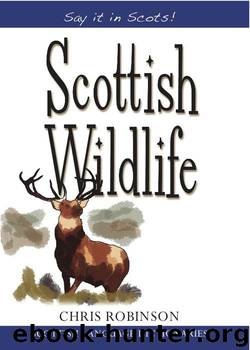Scottish Wildlife by Chris Robinson

Author:Chris Robinson
Language: eng
Format: mobi, epub
ISBN: 9781845028244
Publisher: Black & White Publishing
Published: 2014-02-28T11:00:00+00:00
3 Wee Beasts
And lat no small beistis suffir skaith [harm] na skornis
This quotation from William Dunbar, writing at the beginning of the sixteenth century, makes him sound like the father of nature conservation. In fact it is a tactful suggestion to his monarch in The Thrissel and the Rose that his subjects should be compassionately ruled.
Backie, bawkie – bat. The most common variety of bat in Scotland is the tiny pipistrelle. The next most common variety is the long-eared bat. It is easy to identify; the name gives it away. You may see a Daubenton’s bat, skimming over water, or a Natterer’s bat with its pale underside. Other kinds of bat are rarely seen in Scotland.
Baudrons – hare, cat. See also Bawd, Bawtie, Maukin. The primary meaning of baudrons is ‘cat’ but there seems to be a tendency to extend words for cat to include the hare. Puss is another example of this.
Bawd – hare. Bawd bree is hare soup.
Bawtie – means a rabbit, but, confusingly, it has often been used in the past for the name of a dog. See also Baudrons, Bawd, Maukin.
Foumart – polecat, ferret. See also Whitrat. Foumarts were once hunted for their fur and there was formerly a market for hare, rabbit and polecat skins in Dumfries. Sadly, there are not many polecats left in the wild, but the word is frequently applied to ferrets, especially ones of polecat colouring. A foumart cat has brindled fur. To dae the foumart is to be engaged in shady dealings.
Grey Squirrel – there appears to be an oblique reference to the grey squirrel in A Dictionary of the Older Scottish Tongue in a Latin quotation dated 1331. The quotation refers to pure, which, the dictionary tells us, is the belly fur of the grey squirrel. This is puzzling, since the grey squirrel is native to North America, a place which was not, according to many authorities, discovered until 1492. The grey squirrel was first released in to the wild in the nineteenth century and is a common sight in Edinburgh parks, where they live on a diet of mutton pies and egg sandwiches.
Hedger – hedgehog. See Hurcheon.
Hurcheon – hedgehog. The Mrs Tiggywinkle image was not current in Older Scots. William Dunbar (1508) likens the gait of his fellow poet Kennedy to the ungainly walk of a hedgehog:
Hard hurcheoun, hirpland [limping], hippit [stiff-hipped, walking unevenly] as ane harrow.
He used the hedgehog for another unpleasant image in the Twa Merrit Wemen and the Wedo for the rubbing of a rough old man’s face against a young woman’s cheek:
With his hard hurcheone skyn sa heklis he my chekis.
This mark of affection is also referred to as a ‘bairdie’ and is not universally welcomed by Scotswomen, who, frankly, would rather have chocolates.
Witchcraft, as a result of which Jonett [Janet] … wes trublit with hurchouins, is documented in Pitcairn’s Criminal Trials during a trial in 1591.
The Outer Hebrides are also troubled with hurcheons, which are not native to the islands but were introduced by gardeners to tackle slugs.
Download
This site does not store any files on its server. We only index and link to content provided by other sites. Please contact the content providers to delete copyright contents if any and email us, we'll remove relevant links or contents immediately.
Cecilia; Or, Memoirs of an Heiress — Volume 1 by Fanny Burney(32495)
Cecilia; Or, Memoirs of an Heiress — Volume 2 by Fanny Burney(31909)
Cecilia; Or, Memoirs of an Heiress — Volume 3 by Fanny Burney(31893)
The Lost Art of Listening by Michael P. Nichols(7453)
Asking the Right Questions: A Guide to Critical Thinking by M. Neil Browne & Stuart M. Keeley(5708)
We Need to Talk by Celeste Headlee(5571)
On Writing A Memoir of the Craft by Stephen King(4892)
Dialogue by Robert McKee(4353)
Pre-Suasion: A Revolutionary Way to Influence and Persuade by Robert Cialdini(4183)
I Have Something to Say: Mastering the Art of Public Speaking in an Age of Disconnection by John Bowe(3859)
Elements of Style 2017 by Richard De A'Morelli(3324)
The Book of Human Emotions by Tiffany Watt Smith(3268)
Fluent Forever: How to Learn Any Language Fast and Never Forget It by Gabriel Wyner(3053)
Name Book, The: Over 10,000 Names--Their Meanings, Origins, and Spiritual Significance by Astoria Dorothy(2960)
Good Humor, Bad Taste: A Sociology of the Joke by Kuipers Giselinde(2922)
Why I Write by George Orwell(2913)
The Art Of Deception by Kevin Mitnick(2769)
The Grammaring Guide to English Grammar with Exercises by Péter Simon(2723)
Ancient Worlds by Michael Scott(2650)
